This post may contain affiliate links. For more information, see our privacy policy.
With a triple dose of lemon (in the cake, glaze and icing), this Ridiculously Easy Lemon Buttermilk Cake is also ridiculously delicious, definitely a lemon lover's dream come true!
It seems the lemon is a universally beloved flavor that's in season all year long. This Ridiculously Easy Lemon Buttermilk Cake boasts a triple dose of vibrant lemon flavor - there's lemon zest in the cake, a light lemon glaze that's brushed on the cake after it emerges from the oven and, the crowning glory... a creamy, dreamy lemon buttercream.

The wonderful thing about this Lemon Buttermilk Cake is that it comes together quickly with just one bowl and no mixer necessary. The glaze and buttercream are also super simple and don't require a mixer or any fancy equipment.
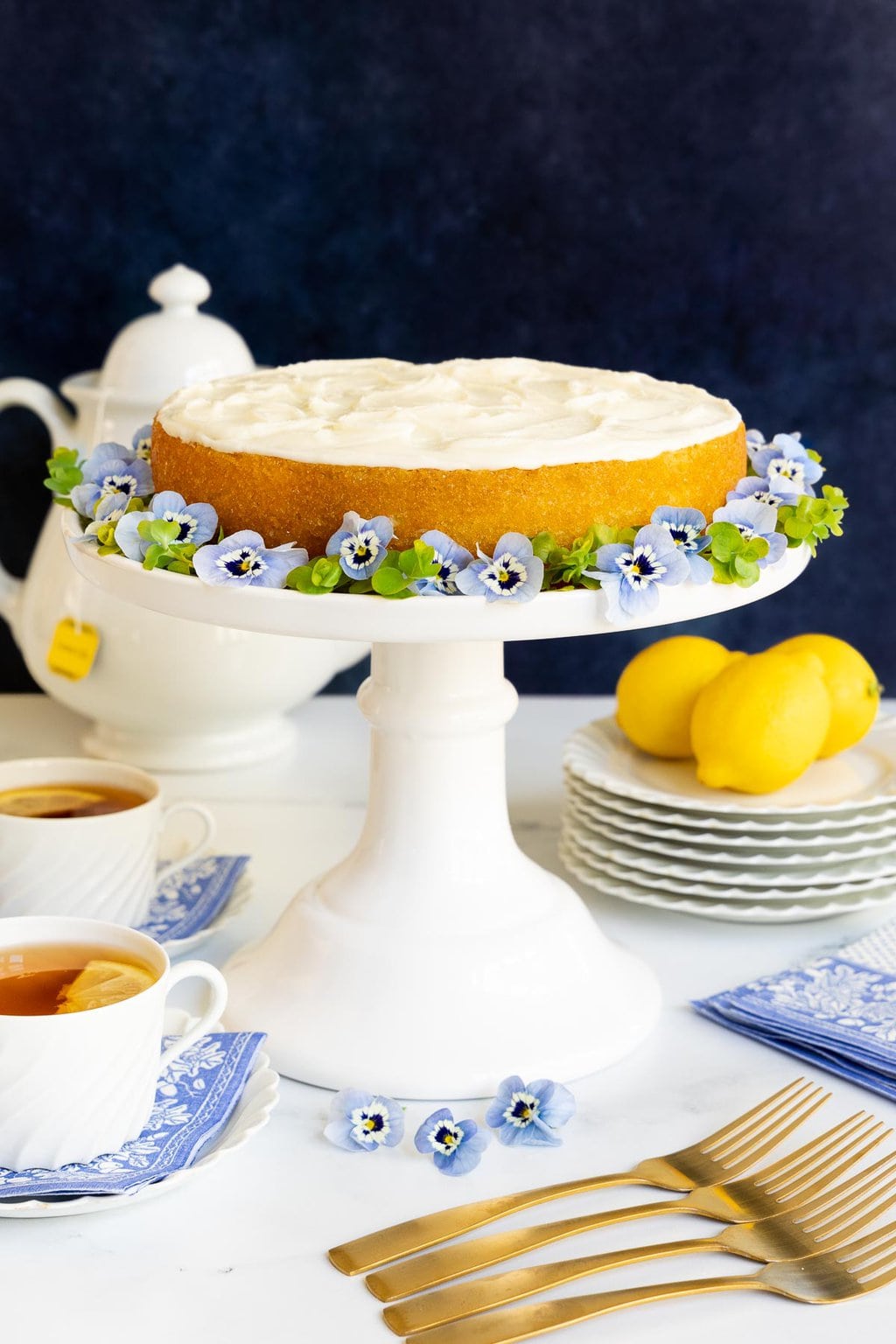
An old friend
If you read through this Lemon Buttermilk Cake recipe you might feel like it's vaguely familiar. If you've made our Vanilla Malt Cake with Robin's Egg Buttercream, it's the same wonderful recipe just dressed up with new clothes... lemon clothes! I love this buttermilk cake recipe, adapted from the cookbook, Snacking Cakes, by

It's a super versatile cake recipe that can go in so many directions. This time I added fresh lemon zest to the cake batter, a lemon glaze that's brushed on after baking and a fabulous lemon buttercream that seals the deal!
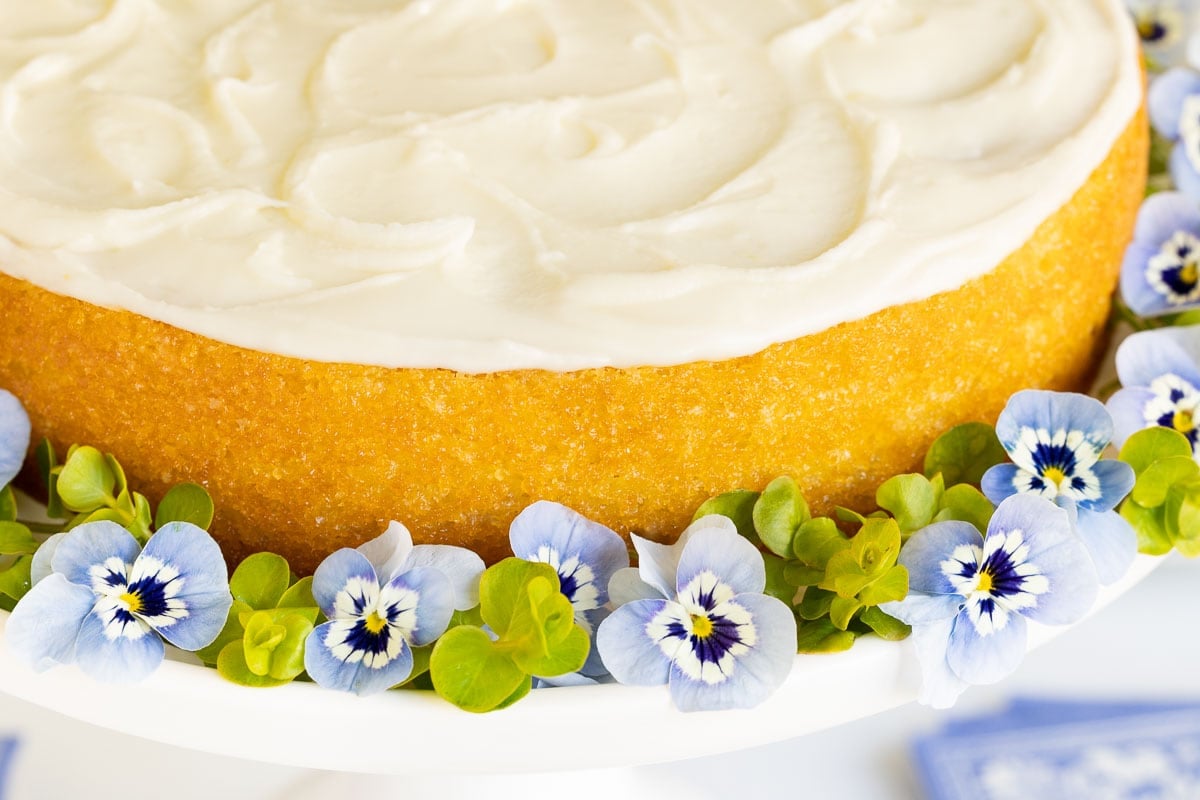
Don't be surprised if you see it again in the future - with a brand-new personality!
Edible flowers
Edible flowers are a fun and beautiful way to decorate cakes, tarts, salads, soups, appetizers... They make everything look really special, even if you're like me and don't have any fancy decorating skills! There are lots of edible flowers to choose from. You may have some growing in your own yard. Here's a list of the more common ones, courtesy of Gardener's Supply:
- Alliums. Chives, leeks and garlic are all delicious in green salads, potato and pasta salads and dips. Remove the central stem from the flower cluster to release the separate florets.
- Nasturtiums. Blossoms have a peppery flavor like watercress. All colors and varieties are tasty in salads or as garnishes. Leaves can be eaten, too.
- Marigolds. Use the tiny flowers of signet marigolds, such as Lemon Gem and Tangerine Gem. Their blossoms have a citrus taste.
- Pansies and Johnny jump-ups. These flowers have a wintergreen flavor and are pretty on cakes and other desserts. Glaze with warmed jelly for a jeweled look.
- Calendula. An easy and prolific edible flower that's easy to grow from seed right in the garden. Separate the petals from the center of the flower and sprinkle the petals into salads. Colors range from pure yellow to orange and red. Remove spent flowers and the plants will bloom continuously from early summer into late fall.
- Anise hyssop. If you like anise, this is the edible flower for you. Separate the florets and add them to sweet or savory dishes. Or use the full flowers to garnish a cheese plate.
- Honeysuckle. The blossoms make a pretty addition to salads. Don't use the berries; they're poisonous.
- Scarlet runner beans. Mix these bright-red flowers into salads, or with steamed veggies.
- Borage. This fuzzy-leaved herb has sky-blue flowers with a light cucumber taste. Add to fruit salads, green salads or freeze in ice cubes for cold drinks.
- Bee balm. This member of the mint family has minty-tasting flowers. Colors range from bright red to purple and pink.
- Chamomile. English chamomile has small, daisy-like flowers with an apple-like flavor. If you're allergic to ragweed, you might want to avoid chamomile.
- Daylily. Daylily buds and flowers taste a bit like asparagus. They can be used as a garnish or can be stuffed or made into fritters. Good in stir-frys, too.
- Mint. Like bee balm, all flowers of the mint family are edible and have a pleasant taste. Try lemon balm or spearmint in iced tea.
- Squash blossoms. Use these as you would daylilies (see above).
Even if you're not going to eat the flowers (we usually don't unless they're in a salad or used as a pretty garnish for a soup) make sure that the ones you choose are edible. You don't want flowers up against your food that could release harmful toxins. Some of the prettiest flowers are quite dangerous if ingested. For example, I absolutely love Lily of the Valley but the flowers, fruit, and leaves are all poisonous and can cause nausea, vomiting and cardiac issues. The same is true for the pretty buttercup which can result in severe irritation of the digestive tract, abdominal pain...
One other caution - avoid flowers that may have been sprayed with an insecticide, fungicide or herbicide. Because most edible flowers are easy to grow yourself, this doesn't have to be a problem.
All this to say, use edible flowers with great abandon but make sure you're using the right ones!
Celebrate a special occasion or make an ordinary day a celebration!
This would be a wonderful cake to celebrate a birthday or special occasion. I served it for our Easter celebration and everyone love it! The cake also travels well so it would be great for picnics and potlucks. And if you have a friend who needs a little encouragement or TLC, this Lemon Buttermilk Cake is perfect!
It's also a great cake to make an ordinary day special since it only takes a few minutes to put together and the results are moist, tender and lemony delicious!
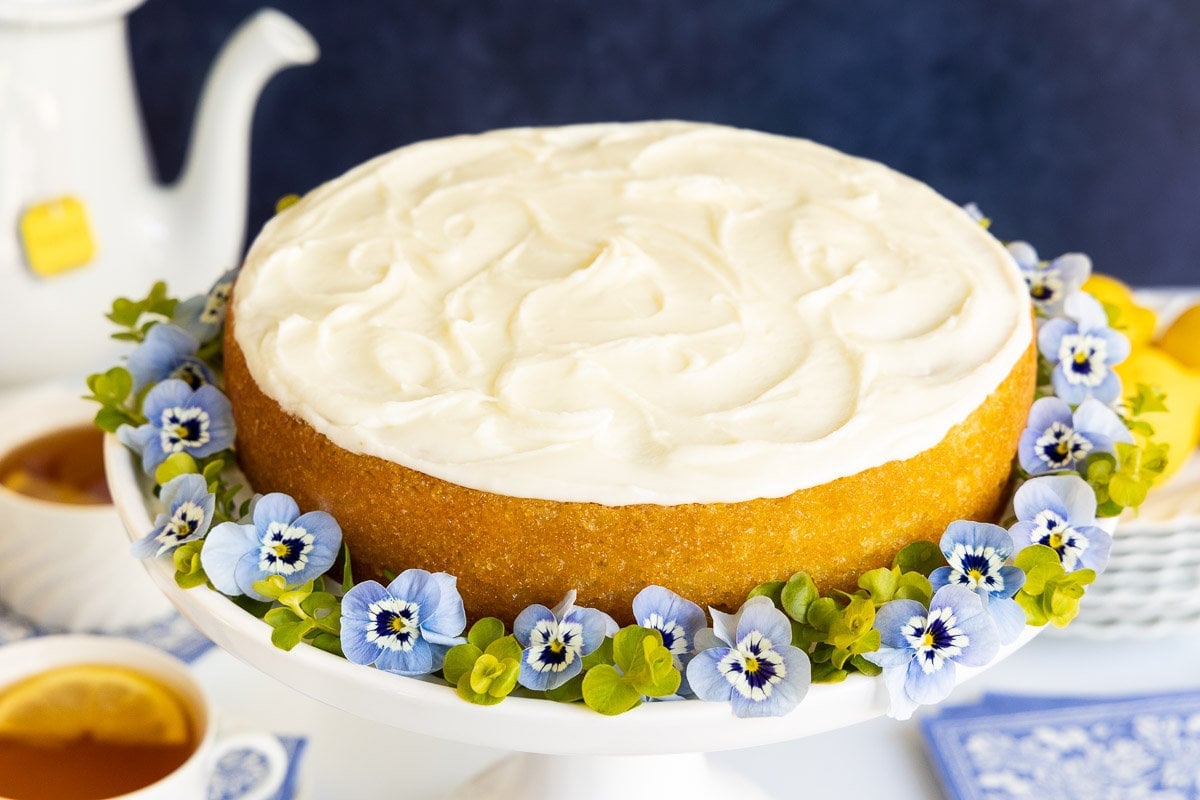
Make this cake!
Whenever or for whoever you decide to serve this Lemon Buttermilk Cake, put it on your must-bake list then pour glasses of cold milk or fix you and a friend a cup of tea.
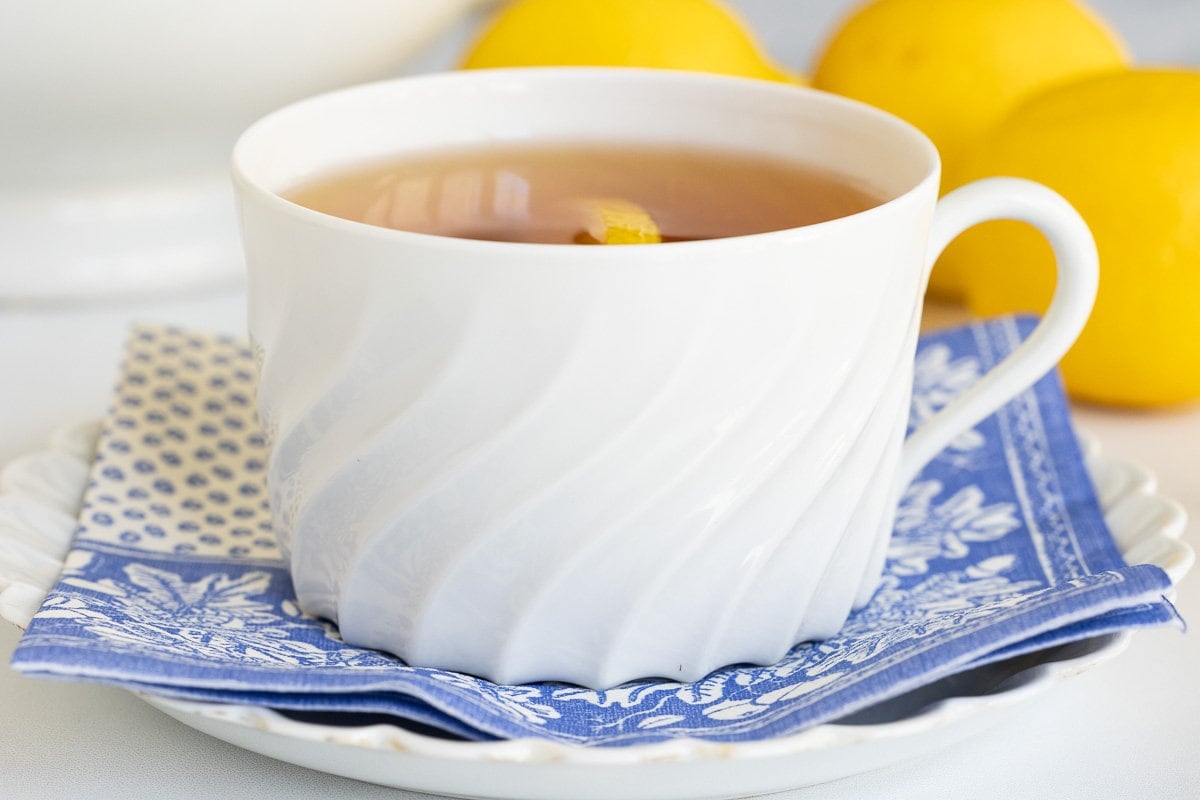
I promise no one will be disappointed and you will definitely make a delicious memory!
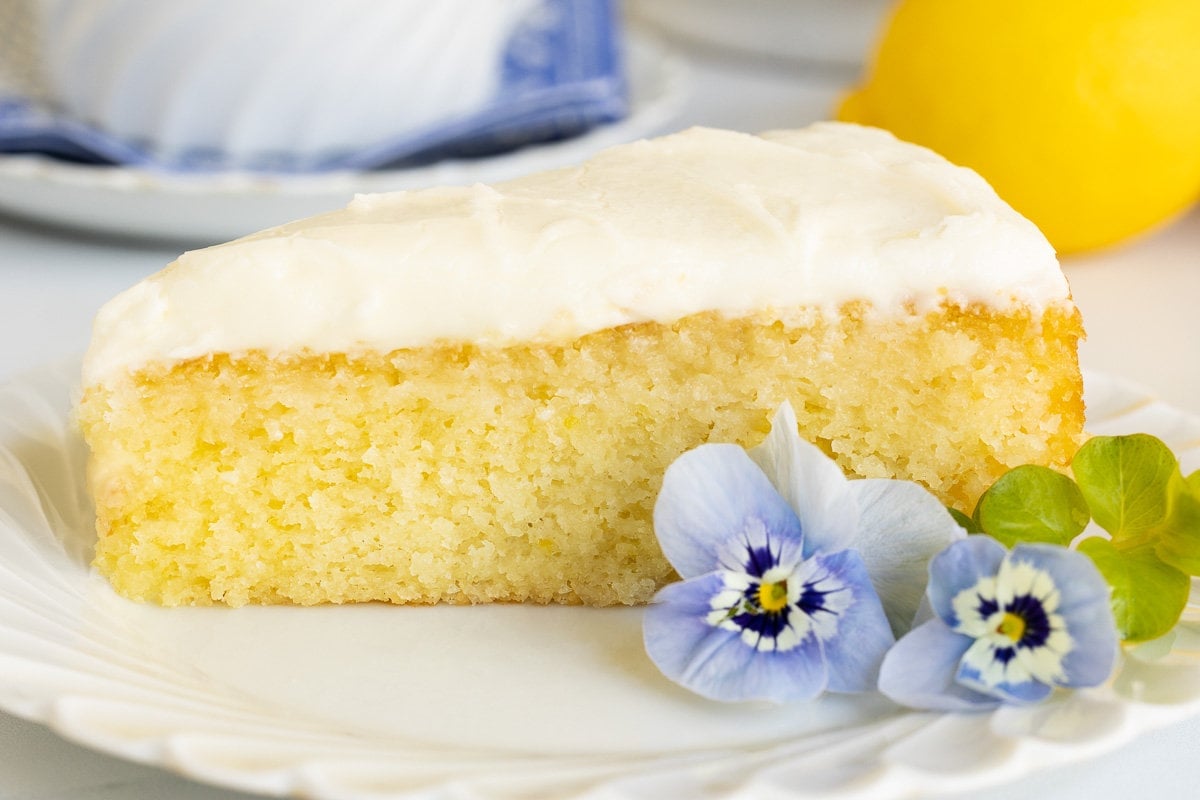
Café Tips for making this Ridiculously Easy Lemon Buttermilk Cake
- This recipe calls for an 8-inch round cake pan with sides that are at least 2 inches tall. If your pan has less than 2-inch tall sides, use a 9-inch pan. The finished cake will be a bit lower.
- I love this textured 8-inch cake pan. I've had mine for years and it's held up well.
- No buttermilk? No problem! You can make your own substitute by adding 1 tablespoon of white vinegar to a liquid measuring cup. Fill the cup with milk up to the 1-cup line and give it a good stir. Wait 5 minutes then stir again - that's it! The milk will thicken just a bit over the 5 minutes.
- Just a note to be aware of - you can use an 8-inch square cake pan but be aware that the cake won't be as tall. The bottom surface area of an 8-inch round pan is 50 square inches whereas the bottom surface area of an 8-inch square pan is 64 square inches,
- Many cakes will mound a bit in the center while baking, this Lemon Buttermilk Cake included. It's because the outer edges start baking sooner than the rest of the cake causing the edges to set before the cake has fully risen. As the cake finished baking the center will dome. The cake will be flipped over after it's baked with the bottom becoming the top, so it's not a big deal. But, if you prefer a perfectly level cake, these velcro cake strips (which are wrapped around the pan before baking) work really well! They can be used for 8 or 9-inch cake pans and can be reused over and over.
- The best way to determine if a cake is done is to use an instant thermometer. The internal temp in the center of the cake should read 200-210˚F. Instant thermometers are super useful in the kitchen and are reasonably priced.
- This Lemon Buttermilk Cake can be made without the icing. It's delicious on its own which is a great option if you're watching your sugar and simply prefer less sweet desserts.
- I like using a large cake spatula to transfer my cakes from the cooling rack to a platter or cake stand.
- For those of you living outside of the U.S., half-and-half is a convenience product that's often used here in coffee. It's simply a combination of half milk and half cream.
Thought for the day:
“Holy, holy, holy is the Lord Almighty;
the whole earth is full of his glory.”
Isaiah 6:3
What we're listening to for inspiration:
If you enjoy this recipe, please come back and leave a star rating and review! It’s so helpful to other readers to hear your results, adaptations, and ideas for variations.
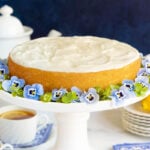
- ¾ cup granulated sugar
- finely grated zest from 1 medium lemon
- 1 large egg
- 1 cup buttermilk
- ¼ cup melted butter
- ¼ cup neutral flavored oil sunflower, safflower, grape seed, avocado, canola…
- 1 teaspoon vanilla extract
- 1 teaspoon baking powder
- ½ teaspoon baking soda
- ½ teaspoon kosher salt
- 1¼ cups all-purpose flour
- ½ cup powdered sugar
- 3 tablespoons fresh lemon juice
- 6 tablespoons butter
- 2 cups powdered sugar maybe a bit more
- 2 tablespoons fresh lemon juice
- 1 tablespoon half and half or milk, maybe a bit more
- ½ teaaspoon vanilla extract
-
Preheat the oven to 325˚F with a rack in the center of the oven. Spray an 8-inch round cake pan (with sides that are at least 2 inches tall) generously with baking spray and rub to coat the inner surface well. Line the bottom of the pan with parchment paper. Set aside. (if your round pam does not have sides that are at least 2 inches tall, use 9-inch pans instead.)
-
Set a cooling rack over a piece of parchment paper and set it aside.
-
In a medium-large bowl, combine the sugar and the lemon zest. With your fingers or a silicone spatula, rub the zest into the sugar until well melded. Take a sniff, you have released the amazing-smelling lemon oils from the zest! Add the egg and whisk for 30-45 seconds until well combined and a little frothy. The yellow color should get a little lighter as you whisk.
-
Add the buttermilk, melted butter, oil and vanilla and whisk until combined. Add baking powder, baking soda and salt. Whisk again until smooth and lump-free.
-
Lastly add the flour and whisk just until smooth. The batter will be fairly thin.
-
Pour the batter into the prepared pan, tap the pan gently on the counter to release any air bubbles, and smooth the top of the batter with a knife or offset spatula. Bake for 40-50 minutes or until golden and a toothpick inserted into the centre comes out clean. The best way to test doneness is with an instant thermometer. The cake is done when the temperature reads 200-210˚F.
-
While the cake is baking, make the glaze (directions below).
-
Allow the cake to cool for 10 minutes then turn it out onto a cooling rack and peel off the parchment paper. The bottom of the cake will now become the top. Brush the cake all over with the lemon glaze. Use all of the glaze. some of it will drip onto the parchment paper but most of it will sink in. Cool completely before topping with the buttercream.
-
Combine all of the glaze ingredients in a microwave-safe measuring cup or bowl and whisk vigorously to combine. If the glaze is still lumpy, place the cup (or bowl) in the microwave and heat on high power for 20-30 seconds. Whisk again until smooth. Set aside.
-
Place the butter in a large microwave-safe bowl. Cover with a paper towel and cook on high power for 30-45 seconds or until melted.
-
Add the powdered sugar, lemon juice and half-and-half and whisk until smooth and creamy. You want a nice spreadable consistency - if the icing seems too thin, add a bit more powdered sugar and whisk well. If it’s too thick, add more half and half (or milk), just a little splash at a time and whisk until smooth.
-
Plop the icing onto the center of the cake and spread it to the edges, swirling it with a knife or the back of a teaspoon for a pretty presentation.
See Café Tips above in the post for more detailed instructions and tips to ensure success.
If you prefer to use Metric measurements there is a button in each of our recipes, right above the word “Instructions”. Just click that button to toggle to grams, milliliters, etc. If you ever come across one of our recipes that doesn't have the Metric conversion (some of the older recipes may not), feel free to leave a comment and I will add it.
Adapted from Snacking Cakes by Yossi Arefi
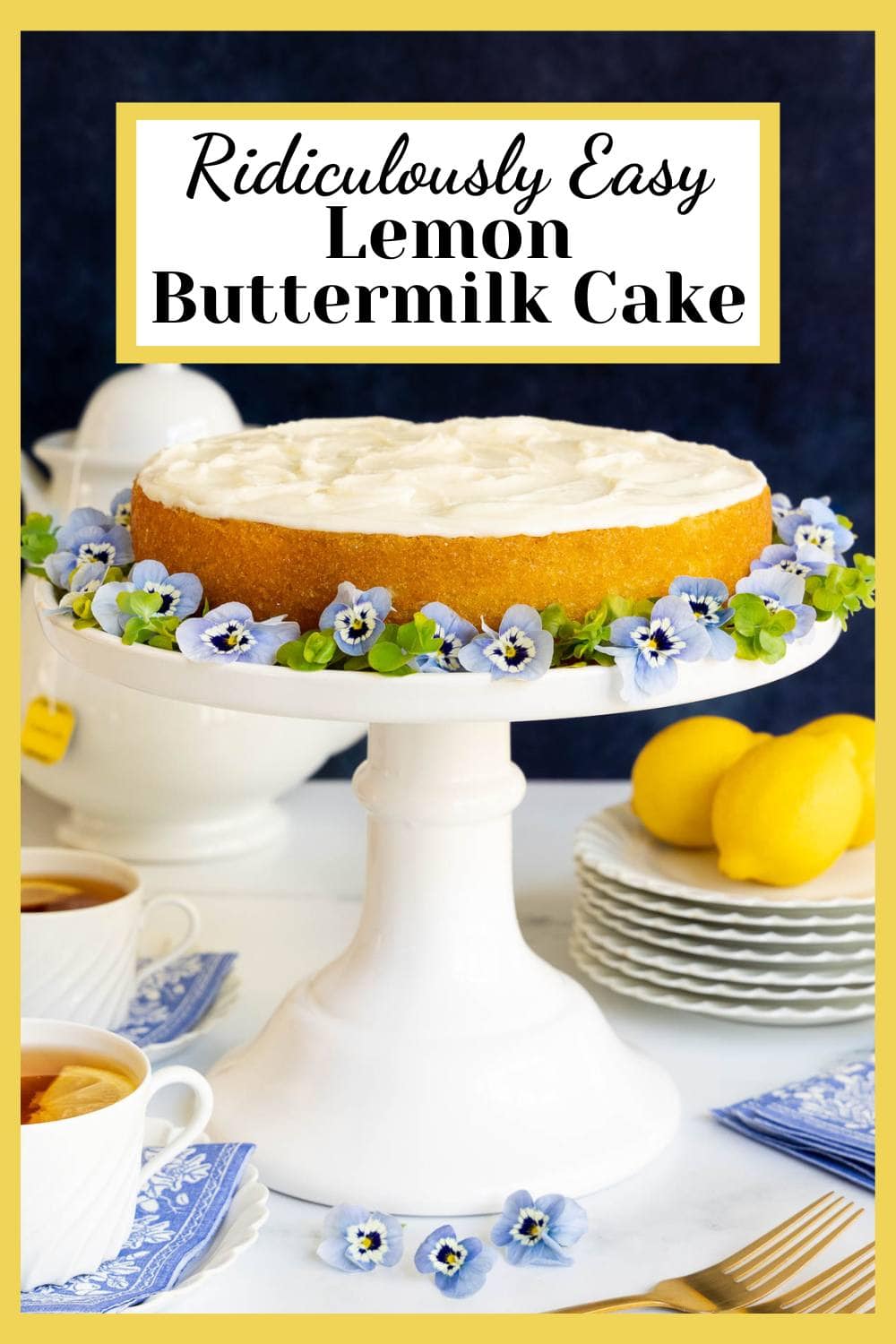


Suzanne Dailey Howard says
Baked this spur of the moment for a friend when I learned today was his birthday and he loved lemons as much as I do. So wonderful; triple lemon flavor in cake, glaze and icing. I had leftover lemons from baking your lemon poppy seed sheet cake for a crowd at Easter and now have two new great recipes. Thank you, Chris.
Lindsay @ The Café Sucre Farine says
Awesome! Thank you for the review, Suzanne!
Jennifer says
How do you store ? In refrigerator or on counter ?
Lindsay @ The Café Sucre Farine says
Hi Jennifer, it's fine on the counter for a day or two, after that we would freeze it to keep it fresh.
Linda says
Made this today. Delicious! Using a Wilton brand 8 inch pan was perfect. Have made many of your recipes and especially love your Bakery Style Lemon Blueberry Muffins. Whenever I give them to friends they always want them again, and again. Even had a recent store asking me to bake them so they could sell. Keep the delicious recipes coming!
Lindsay @ The Café Sucre Farine says
That's awesome, Linda! Thanks for your review!
hobby baker Kelly says
This was an absolutely fantastic cake, and so easy! One we will make again and again. Everyone loved it.
Lindsay @ The Café Sucre Farine says
Awesome! Thanks for your review, Kelly!
M collins says
Can this be doubled and then tiered? My mom loves lemon cake and I would like to use it it to make her birthday cake, but I don't know if it can be stacked on top of each other.
Lindsay @ The Café Sucre Farine says
Yes, that will work. Enjoy, M!
Cynthia says
Hello Chris
Thank you very much for your recipes. I baked the Lemon Buttermilk Cake today and all is well -- so tasty. I'm working with an old oven that is inconsistent, so I need to check the time on all recipes. I loved the glaze and now feel comfortable baking with buttermilk. I purchased a good brand of whole buttermilk and I really think it's great. Best wishes, Cynthia
Lindsay @ The Café Sucre Farine says
That's great, Cynthia! Thanks for your comment.
Nina says
Basically made my own frankencake. Doubled the recipe, added a few tablespoons of sour cream since I only had 1% buttermilk, and baked it in a bundt pan. Also made my own lemon glaze, closer to a thick lemon icing. It came out incredibly moist with a very tender crumb. I'm sure the original recipe is great but I was feeling even more lazy than it allowed. Ended up with what I would consider akin to the best lemon pound cake. Thanks for the recipe!
Lindsay @ The Café Sucre Farine says
Thanks for your review, Nina!
Rosemary Anne Moffitt says
I have baked this cake three times and all who have shared in the cake each time have commented on how incredible the flavour is.
I made two double layers this week-end , certainly flop proof and most delicious. Thank you for the recipe 🙂
Chris Scheuer says
I'm so happy you enjoyed this recipe, Rosemary. Thanks so much for taking the time to leave a review!
Mary says
Has anyone froze this cake, and frosted later upon serving??
Lindsay @ The Café Sucre Farine says
That will work, Mary. Enjoy!
Jeanne says
Another winner! We love lemon and this recipe delivers good lemon flavor. It's good the first day but even more moist the second and third day. Even though there's only two of us, it likely won't make it to the fourth day. Serves 12? Not in my world---too good!
Lindsay @ The Café Sucre Farine says
So glad you enjoyed this, Jeanne!
Amy says
I made this for dessert tonight and my 8 year old granddaughter said she gives it “ a 1000 thumbs up! “
It was really delicious!
Lindsay @ The Café Sucre Farine says
Awesome! Thanks for letting us know, Amy!
Bon says
Coujd hardly wait until it cooled to sample. Did the glaze only. It is so moist and delicious. Love it and looking forward to sharing with family.
Chris Scheuer says
Hi Bon, thanks for sharing your review! So happy you enjoyed it
Scott says
Recipe calls for glaxe, instructions say to set aside, no mention how the glaze is used. Help!!!!!
Chris Scheuer says
Hi Scott, look at step six under the cake directions. It tells you how to brush it on the cake.
Peggy L Mitchell says
Could this be adapted for gluten free?
Chris Scheuer says
Hi Peggy, I haven't tested this recipe with GF flour but I think it could work!
Anju says
Can this cake be made without egg. What can I sub for eggs
Chris Scheuer says
Hi Anju, I haven't tested this recipe without eggs. Eggs are integral for the texture though so you might be better off going with a recipe that has been designed to be delicious without eggs.
Claudette says
Ingredients call for 1 large egg but steps mention EGGS, plural. I want to make this recipe so badly but don't want to mess it up. Which is it?
Chris Scheuer says
Hi Claudette, you are very observant! Thanks for noticing that. It was a typo - you'll need just one egg. Hope you enjoy it!
Tulsi says
I would like to make this for a larger group. Would it work to double the recipe and bake in a 9 x 13" pan? What do you think the bake time would be? Thanks.
Chris Scheuer says
Hi Tulsi, this should work fine in a 9x13-inch pan. The baking time will be longer but since I haven't tested the recipe in that size pan, I can't give you an exact time. I would check after 35 minutes and every little bit after that. The best way to determine doneness is with an instant thermometer which should read 200-210˚F.
Lyn Turner says
Must try this recipe soon. We love lemon anything. I made the Italian lemon ricotta cake for Easter and it was a huge hit. I was running low on vanilla, don’t know how I let that happen, so I used almond extract in the icing and we really liked, it. I usually try not to substitute anything on a recipe the first time around but this ended up being a happy substitution . I love these easy recipes ,one bowl no mess. Keep them coming. Great job.
Lindsay @ The Café Sucre Farine says
Thanks so much, Lyn!
susan says
I SO LOVE LEMONS! I love lavender lemonade. I love cherry lemonade. I love lemon cake, cupcakes, lemonade with ice on the porch.
While reading this I thought about oranges. I bet they would also be good. Orange juice can't be mixed with lavender.
I'm making this soon and will probably eat it all in a few days! I cannot wait. I love buttermilk in anything. Cornbread, biscuits, even bread (but ofcourse, that's better with sourdough!).
Thanks for coming up with so many GREAT ideas. So far, I've loved them all.
And I love the scriptures at the bottom! When my son used to go to camp, they had a "rock" song called Awsome God. It was rattling, but very cool for the younger folks, and it gave them a way to keep the tune in their heads thru the week. Kept their minds on God. A good thing.
Happy April!
Lindsay @ The Café Sucre Farine says
Thanks for your kind comment, April! So glad you are enjoying the scriptures and the recipes 🙂